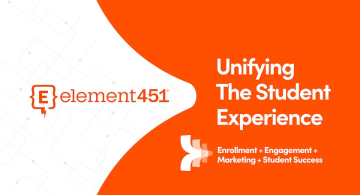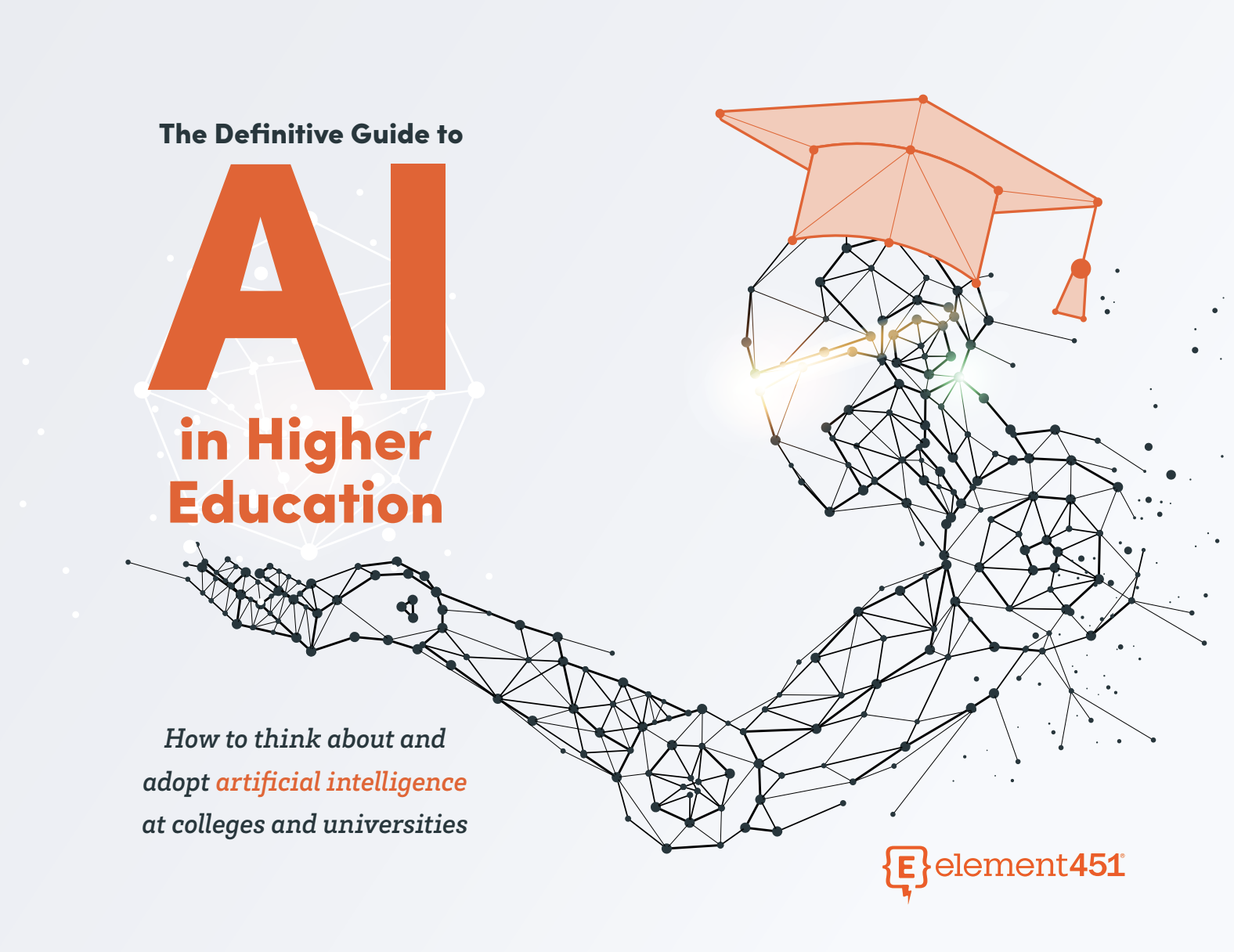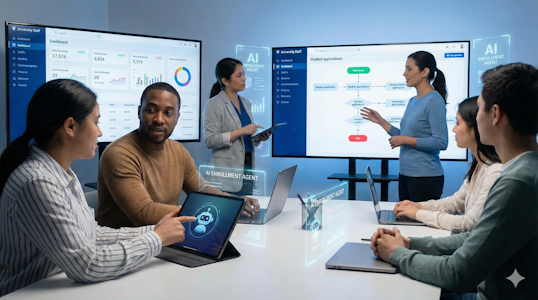Rebounding From the Pandemic with Mordecai Brownlee, President of Community College of Aurora
by Sirley Carballo · Updated Oct 19, 2021

Element451 is proud to announce the In Your Element Podcast, part of the Enrollify Podcast Network. This fast-paced show drops listeners into a compelling conversation about higher education. In Your Element asks innovative leaders about the challenges, wins, and future of everything from meeting enrollment numbers to equity in education.
On Episode 1 of In Your Element, Eric Stoller has a deep-dive conversation with Mordecai Brownlee, President of Community College of Aurora. Tune into this episode to learn the following:
- How does someone with a student affairs background become a community college president?
- What’s the 6-month plan for a new higher ed president?
- How do community colleges rebound from the damage done by the pandemic?
- How does student engagement happen with community college students?
Listen to Episode 1 of the In Your Element podcast here.

In a lot of cases, we tell students in these spaces, in community college, to dream and 'what are your dreams?' and 'what is it that you want to be?' Well, some cases, especially depending upon the community, they've never been asked that question before, they haven't been given the privilege to dream.

Full Transcript of Episode 1
Eric
Welcome to In Your Element, a podcast on the Enrollify Podcast Network brought to you by Element451, an advanced student engagement CRM, providing higher ed institutions with a competitive admissions advantage from recruitment to enrollment through the use of AI. On each show, we ask five questions about current challenges, exciting opportunities, and what's next in higher education. I'm your host, Eric Stoller. And on today's show, is Dr. Mordecai Brownlee, who's the president of the Community College of Aurora, with campuses in both Aurora and Denver, Colorado. You know, in higher education, students have many choices. And for some, the first choice is whether they want community college or traditional four year programs. across the United States, there are about 1000 public community colleges, and they offer a more affordable experience for those who want flexibility and want to stay closer to home and frankly, don't want a mountain of debt after they graduate. But like all higher ed institutions, community colleges struggled throughout the pandemic, because well, among other reasons, students who typically went to community college had other responsibilities they needed to take care of. For Mordecai Brownlee, he may have started in community college, but that's not where he envisioned his career would end up.
Mordecai
I'm a proud product of community college, and you know not just at the developmental levels. Being an educator was not on my to do list Eric, I was more focused on becoming the next MTV vj, BET vj and pursuing music, man that's where my passions were. But you know, something interesting happened along my path where I had to take on some work study jobs at the college. And that's where I was exposed to higher education as a career.
Eric
Mordecai fell in love with the transformational power of community colleges. And he's dedicated his career to being a part of that. And that's where we start today, with his perspective coming from the student side of community college. I love your, you know, sort of path as a student affairs person, you know, from rec sports, you know, student life, that sort of student affairs, you know, story that a lot of people have. And so it's good to see sort of a student affairs person in the presidency and for an institution because you know, someone, someone from a traditional student affairs background, how does that inform your views as a community college president now?
Mordecai
Well, you know, it's so important that when we, especially as we think about administration, in higher education, a lot of the agenda is driven by KPIs, key performance indicators, and those key performance indicators as we think about a dashboard, are numbers right? And it's so important to remember that those numbers are lives. And what we do impacts not only just that life, but the life of those within that household. And potentially the bloodline as a whole as we think about first generation students, as we think about just the various populations that our institutions serve. And so Student Affairs as a whole really was that qualitative to the quantitative, it really was that relationship, it was the person behind the number and really grasping out to to have connection with those students outside of the classroom. So now with a deeper appreciation of what's happening inside the classroom, they get to inform holistically to advance an institution as a whole.
Eric
I love it, I love it. I love a student affairs sort of viewpoint and focus, you know, sort of at the leadership level, because it gives you just a different lens, you know, nothing wrong with coming from sort of the typical academic background and that sense, you know, as you know, faculty and whatnot, but I think it just is a different perspective. Speaking of that perspective, we've known each other for quite a while now, since we were little kids practically in sort of the higher ed space. But I just, you know, I've seen your career. It's like a rocket ship, man, you've really you kind of ascended through the ranks in many ways. You've had a lot of different opportunities. But you know, at Aurora at CCA now, what's your next six months to a year look like in terms of that sort of high level thinking and high level plans?
Mordecai
You know, one of the things that caused for me to fall in love with CCA was its vision and the vision being to aspire to be a college where every student succeeds. I think about the responsibility that we have as educators. We are the catalysts for change from a societal standpoint, as we think about social mobility, economic mobility, we're in for the next six months to a year, really delving into our institutional mission, really delving into our strategic plan, really building relationships with our faculty and staff, our students, and really looking at what is it that's going to take us to the next level? We're a very young institution, Eric, we're 38 years old. So it's amazing, you know, and I'm just...
Eric
I'm older than your school...
Mordecai
Right? You know, and so many are, right? And so in thinking about this, this is like, this is this is exciting, we're vibrant. We're still finding ourselves in a lot of ways. You know, and coming from serving in an institution that was 123 years old to come to an institution, that's 38 years old. It's like, wow, now let's talk about what is the next 20 years look like for us. But now is the time to chart that path. And so I think that along with the excitement, also comes a responsibility. As we talk about educational technology, as we talk about the advancements of higher education, that an institution like us, we cannot afford to not be a part of the wave of change, innovation. And so that's part of that responsibility that I think we have before us.
Eric
Do you think there's less sort of status quo, or this is the way things have always been done? Because the institution isn't 123 years old?
Mordecai
Exactly. Right. So now now's the time to where you know, you have these conversations? Well, that's the way that we've always done it well, in comparison to the body as a whole. Well, you know, we're at our infancy in a lot of ways. So now's the time to where we can grow through the various stages and really have conversations about how do we, we learn and we evaluate, and we assess, but we really adopt excellence, and innovation, and really think about what's around the corner, because due to our youth, we have the ability, I think to pivot a whole lot quicker than some of our larger, more long standing institutions.
Eric
Yeah, well, I was just thinking about the idea of the status quo, and what the heck that even means after 2019 and then whatever, 2020 being what it was with regards to the pandemic, I don't think anybody could have sort of said, you know, we have the status quo now, because everything, everything changed, you know, it was a super challenging year, to say the least. And I just think about how challenging it was, especially for community colleges. With regards to enrollment, specifically, you know, how do you turn that around?
Mordecai
You know, and I've written about this, and we'll continue to write about this with Edsurge. And, you know, it's it's very, it's very important to things that we keep in mind as we talk about the enrollment realities at community colleges, community colleges tend to serve the low socio economic communities in our country, rural communities in our country and these communities were hit very, very, very hard by the pandemic, matter of fact, their road to recovery is going to look a whole lot different than middle class, upper class America, in comparison, and so the question really became, well, what do we do as, if you will, frontline institutions towards social and economic mobility, and really pivot towards advocacy being the primary focus, whereas enrollments weren't necessarily the focus. So a lot of institutions were able to successfully make that pivot and understand that whether or not the student was enrolled or not, you still have a responsibility to their livelihood. And we really adopted that in my previous institution of reaching out to students that were not even enrolled, but to say, what are the resources you need, because this time will pass, but we need to make sure you have what you need, because that's our responsibility to you. I think that as we move beyond the pandemic, you know, it's a bit concerning now, as we think about the Delta variant, and what all is happening with that. But as we continue to move through the pandemic, and beyond the pandemic, now is the time really, for community colleges to delve into the two key areas, one of those being accessibility, and not just from an internet broadband standpoint, that's a whole other conversation, but the accessibility of what we've been offering and really ask ourselves, is it relevant in this space? And I think that if we were responsible and honest with ourselves, we'll find that some of the things that we've been doing isn't relevant. And I think the second part of that really is a call towards increased advocacy of the communities in which we serve, who we serve, how we serve, and who else we need to be serving.
Eric
Well, when you start talking about that, I hear change, right? I hear change as a central tenet of all that, you know, in terms of some of the stuff that you know, has been done in the past that might not work, or be part of the vision going forward. How do you get everybody to rally around that when maybe they're not part going to be part of that vision?
Mordecai
Yeah, you know, here's the thing, student centeredness, students first, right? It's so important, again, as educators that we keep the students at the forefront of our minds at the center of everything that we do, and be willing and brave enough to ask our students what do they need and what do they want. Be willing to do the market research that's associated with the communities that we serve and the future of those communities. You know, the census data just recently came out, you know, this is information that we need to be paying attention to, and looking at market advancements, you know, disruptive technologies, bio technologies, nanotechnology. Really ask ourselves, where are we relevant? Where are we not present? We need to be a part of that change that's happening around us. So it certainly needs to happen within the academy.
Eric
Yeah, now it makes total sense. I mean, I, myself am a community college graduate and I, you know, got my associates degree, played in the jazz band. My brother went to the same exact community college a few years after I did, but he did a technical program, you know, got into optics, very different experiences, but both had sort of a transformative experience at the community college level. Now, I noticed you dropped Edsurge, you know, put that sort of nerd cred out there for all to hear. You know, you're a columnist, I believe, for Edsurge. You know, Edsurge is a publication I read as one of the leading edtech publications out there. I'm assuming you've got your you know, your digital finger on the pulse. You know, what technologies do you see as being most important for the future of student success, specifically at Aurora, but you know, even beyond.
Mordecai
Yeah even beyond right? Without doing any name dropping, just speaking from a broad, broad brush aspect, it's so important that community colleges, especially, embrace technology, if we just think about career and technical education, as we think about that lab space, as a whole, it's been a lot of hands on, however, industry has continued to evolve into these more technological spaces. And so it's imperative that we infuse technology, even in career and technical education. As we look again, at these various disruptive technologies, it's been a whole lot of what we've done, that's been the former approach to teaching and learning in that space, then now we have to say, well, let's look and seek out new partners, let's look at new opportunities to train and teach in these advancements of technology. Because you know, the last thing we need to be able to say, as a sector is that well, "we taught them on this information on this equipment, this previous technology, former generations, yet you're going to learn something when you get out there on the market". And the true realization is we've done you a disservice. Now on the other end, as we talk about strategic enrollment management, right, we need to see even more integrations of technology in those spaces, teaching and learning well beyond just saying, "well, respond to two of your classmates on their weekly posts, and consider that to be an innovation". So it's now a time where we're really having these interactions, because society as a whole has already pivoted in a certain realm of community, how do we bring that form of community into the community college space, you know, resources can no longer be the excuse. I understand that, you know, especially in community college spaces, frequented are the conversations about the lack of resources, or the lack of funds available, however, I would highly encourage leaders to really understand that unless you invest into your own academies, there's no way for them to, again, increase their relevance and market and move towards being more revenue driven.
Eric
Yeah, yeah, to get to put put some resources in there in order to generate that expansion and amplification. You know, one thing that I hear in what you're saying is this little bit of an idea around persistence, you know, and I'm kind of reading between the lines a little bit, you know, and when I was at a community college can I was on my own really, you know, and I felt as if, you know, I was kind of a little bit homesick, didn't have, you know, connections right away. Fortunately, I found sort of that musical angle. It's kind of funny, we both have that musical side of things, but it's like, how do you? How do you work on persistence with community college students, when you know, it's a completely different mission, vision and and even outcomes than say, like your traditional four year institution?
Mordecai
By design, is the short of that answer. By design, an institution can increase its retention, its persistence, and student success through design - proper, intentional design. And I think that that really comes down to, you heard me earlier, say, student centeredness. But the question really becomes, how do we capture the attention of prospective students? How do we engage our current students, those that have entrusted us with their academic and career pathways? And then how do we incentivize their persistence? And so even though they have a dream, the reality is, each and every one of us have a carrot that we're perhaps being influenced by. And the question is, is in a lot of cases, we tell students in these spaces in community college to dream, and what are your dreams? And what is it that you want to be? Well, some cases, especially depending upon the community, they've never been asked that question before, they haven't been given the privilege to dream. And so this is the first time where they're being given an opportunity to develop a personal strategic plan for themselves, to think about what are the opportunities out there available to them. So I say by design. By design, we have to teach the students how to dream, how to develop their own carrots, how to resource themselves and build a network around them, whereas they have never had one perhaps, and to create stackable short term credentialing situations that incentivize their continued progression through the academy.
Eric
Well, you opened up a whole can there with the stackable credits and sort of the, you know, different pathways to success. I mean, there's a lot of students that went into four year institutions and didn't finish and they're stuck with a handful of credits that they can't do anything with. And I'm assuming similarly, you know, community college students have the same issues.
Mordecai
Absolutely, man, you know, one of the things that I would say, and I'm a big fan of is the guided pathway model in this community college space, because as we think about the responsibility that we have for students, your urban, your rural, low socio economic, heavily impacted by the pandemic, this population does not have the time to waste on credentials and credits that they will never utilize. And so if it's taking you 90 plus hours to attain a 60 hour credential, or even 60 plus hours to attain a 30 hour credential, we've just now wasted time, space, resources that are critical to their continued progression, and retention and persistence through their career in the academic pathway. So again, we have the responsibility to create more efficient pathways towards completion.
Eric
Thanks for that. That's great answer. Yeah, I was thinking about when we met the first time, I think was in person. And it was kind of like a Hi, how are ya? And then we've continued our sort of our relationship, our friendship, via, you know, did all things digital social networks and what have you? And so I think I'd be remiss if I didn't ask this question, I, you know, I wrote it up, I want to make sure I get it in here. I kind of get the idea of what student engagement from digital landscape looks like for that four year institution, maybe a little bit more, just because that's kind of the space I've worked at the most. But what does student engagement look like for community college students? When that landscape of digital, you know, is ever increasing?
Mordecai
You know, and I would, the best answer I have for that is that it is evolving, right? So the question really becomes: where can we create communities through cohort opportunities based on programmatic interest? Because again, in this community, common space, you're dealing with students that are working adults, in a lot of cases, right, and they've got a short amount of time on your campus to attain that credential, to further themselves, perhaps, in industry, or they're making their way to you with the desires of transferring to more four year spaces. So our engagements with these students are very short term. And the question becomes: where do we create community? Well, a lot of that is within the classroom. And so I have a deep appreciation for our faculty in the communities in which they createand thrive and nurture, because that's where the students are coming and interacting, and they got a short window of space outside of that, which is where we now have experiential learning opportunities, cocurricular learning opportunities that we must exercise. So the short of it is that it is evolving, but it is critical, especially in community college, that we partner with faculty, where the students are in the classroom, to create further and deeper community. And also there are creative ways in which we can further the learning happening inside the classroom outside the classroom. And students can see the importance of having such engagement.
Eric
Yeah, yeah, well, especially when, you know, people have all sorts of stuff going on in their lives. They're working, they got families, they got other obligations, how do you reach them? When there's just so much going on? Like, it's it's like, how do you capture that attention? You know, everyone always says, well, students don't read emails or students, you know, they're not engaging with our stuff, like anything in particular that you've seen this worked really well, for community college students?
Mordecai
Yeah again, that advocacy is critical. I think about the work that I did previously at St. Philip's College, how we developed two advocacy centers, we established them on our respective campuses. Critical. I think about the students that were utilizing those services. You had situations where we had set up funds, in partnership with an entity there in Texas, that had funded emergency grants for students that maybe their lights were turned off, their gas was turned off, they're getting ready to be evicted from their homes, and they're able to receive funds directly from the institution to fund their their crisis. And they didn't have to pay it back. And I'm proud to say that during my tenure, that 100% of the students that received those resources, were able to complete their programs. And that's the significant, right? As we think about points of crisis, I am not going to complete my homework assignment. If I have no power on in my house, I cannot achieve the learning outcomes associated with the course, if I don't have internet access. So as this seems to be common sense, life in itself is not lived within common sense. It's lived at points of crisis and how we teach students to persist through those points of crisis and that's where the community college really does its work. So, student advocacy is critical but it also cements the relationship between the student in the institution to inform them that we truly care about who you are as an individual.
Eric
Yeah, it reminds me of the old the old adage, you know, meeting students where they are, but perhaps this is more about, you know, supporting students with what they need as step one before you do anything else. Well, you've kind of run the gauntlet through most of my questions, sir. So I've got you know, just one more question. I call it the bonus question. Okay. You gotta love this one, right? Because as president of the institution, you know, you've got your finger on the pulse of a lot of things. But you've got an unlimited budget. What's one technological move that you would make to ensure and enhance student persistence? Very blue sky thinking.
Mordecai
That's a great question.
Eric
That's always a good answer. That means it's a tough one.
Mordecai
That's a tough one. I love it, you know, ensuring accessibility, I believe ensuring this accessibility, I think that as we reflect on the communities in which we serve, some rural, some urban, accessibility can no longer be a part of the question. Students should be able to access their education and the services that they need at any point. And given time, I would also dare to say at any time of the day, right, as we think about education, we tend to keep banker hours. And life is lived and learned beyond the hours of eight and five, so accessibility in terms of their access to broadband, but accessibility also in terms of services being provided to them on what we have traditionally called "after hours".
Eric
Yeah, that's a great answer. And I'm glad I got at least one tough question on the show. But this is wonderful. Thanks so much for participating.
Mordecai
Well, Eric, again, it's been it's been an honor to to befriend you all these years. And thank you for all the work that you're doing. And I would just say to anyone that's taking the time to watch or, excuse me, to listen to this podcast, right?
Eric
I'll have to leak the video, right?
Mordecai
Leak the video, right? I'm good with that. But to anyone who's listening, be encouraged, especially as an educator be encouraged and this work that you're doing, this work that we're doing to transform lives, and know that you have an entire community available to you. All you have to do is say I need help. I need encouragement. I need resources. Social media is key and an amazing opportunity. And it's where we can as a community, encourage and support one another.
Eric
Fantastic. Well, Dr. Mordecai Brownlee, thanks so much for being on In Your Element. Thank you.
That was Dr. Mordecai Brownlee, president of the Community College of Aurora. For more information on CCA visit ccaurora.edu. Thank you for listening to In Your Element brought to you by Element451 and part of the Enrollify Podcast Network. You can find more about the lement451 student engagement CRM at Element451.com. And if you liked what you heard today, please give us a rating and review and follow along on Apple podcasts, Spotify, or wherever you get your podcasts. I'm Eric Stoller and we'll see you next time on In Your Element.

About Element451
Boost enrollment, improve engagement, and support students with an AI workforce built for higher ed. Element451 makes personalization scalable and success repeatable.
Categories
New Blog Posts

The Definitive Guide
AI in Higher Education
Bridge the gap between the latest tech advancements and your institution's success.
Related Articles

Talk With Us
Element451 is the only AI Workforce Platform for higher education. Our friendly experts are here to help you explore how Element451 can improve outcomes for your school.
Get a Demo







